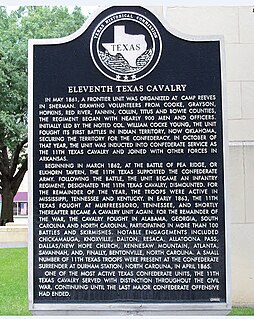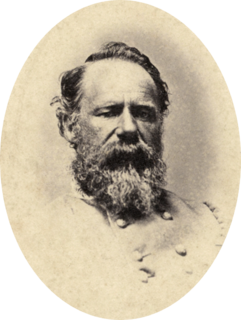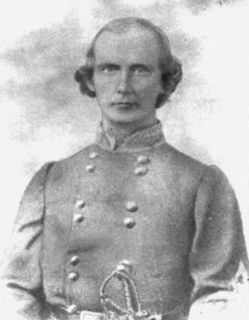
The New Mexico campaign was a military operation of the Trans-Mississippi Theater of the American Civil War from February to April 1862 in which Confederate Brigadier General Henry Hopkins Sibley invaded the northern New Mexico Territory in an attempt to gain control of the Southwest, including the gold fields of Colorado and the ports of California. Historians regard this campaign as the most ambitious Confederate attempt to establish control of the American West and to open an additional theater in the war. It was an important campaign in the war's Trans-Mississippi Theater, and one of the major events in the history of the New Mexico Territory in the American Civil War.

The 9th Texas Cavalry Regiment was a unit of mounted volunteers that fought in the Confederate States Army during the American Civil War. The regiment fought at Round Mountain and Bird Creek (Chusto-Talasah) in 1861, Pea Ridge, Siege of Corinth, Second Corinth, Hatchie's Bridge and the Holly Springs Raid in 1862, and in the Atlanta campaign, Franklin, and Murfreesboro in 1864. The unit fought dismounted at Second Corinth and Hatchie's Bridge before being remounted as cavalry for the remainder of the war. The regiment surrendered to Federal forces on 4 May 1865 and its remaining personnel were paroled.

The 10th Texas Infantry Regiment was a unit of Confederate States Army infantry volunteers organized in October 1861 that fought during the American Civil War. The regiment was captured in its first major action at Arkansas Post in January 1863. After being exchanged three months later, the 10th Texas was consolidated with two other regiments and assigned to Patrick Cleburne's division. Subsequently, the consolidated regiment fought at Chickamauga, Missionary Ridge, and Ringgold Gap in 1863. After becoming an independent regiment again, the 10th Texas fought in the Atlanta Campaign, and at Franklin and Nashville in 1864. After a second consolidation the troops fought at Averasborough and Bentonville in 1865. The regiment's soldiers surrendered to Federal forces on 26 April 1865.

The 3rd Texas Cavalry Regiment or South Kansas-Texas Mounted Volunteers was a unit of mounted volunteers that fought in the Confederate States Army during the American Civil War. The regiment fought at Wilson's Creek and Chustenahlah in 1861, Pea Ridge, Corinth siege, Iuka, Second Corinth, and the Holly Springs Raid in 1862, Thompson's Station in 1863, and at Yazoo City, in the Atlanta campaign, and at Nashville in 1864. The regiment fought dismounted at Iuka and Second Corinth before being remounted for the rest of the war. The regiment surrendered to Federal forces in May 1865 and its remaining 207 men were paroled.

The 11th Texas Cavalry Regiment was a unit of mounted volunteers that fought in the Confederate States Army during the American Civil War. The regiment organized in October 1861 and fought at Chustenahlah against pro-Union Native Americans that winter and at Pea Ridge against Union troops in March 1862. The regiment dismounted to fight at First Corinth, Richmond, and Stones River in 1862. After being remounted, the 11th Texas Cavalry fought at Chickamauga, in Wheeler's October 1863 Raid, in the Atlanta campaign, in Sherman's March to the Sea, and in the Carolinas campaign. When the Confederate army surrendered in April 1865, its remaining soldiers dispersed.

The 10th Texas Cavalry Regiment was a unit of mounted volunteers in the Confederate States Army which fought during the American Civil War. The regiment mustered as cavalry in October 1861 but was dismounted in April 1862 and served as infantry for the rest of the war. The regiment was present at the Siege of Corinth, and fought at Richmond, Ky., Stones River, and Chickamauga in 1862–1863, in the Meridian and Atlanta campaigns and at Nashville in 1864, and at Spanish Fort and Fort Blakeley in 1865. The remaining 65 members of the regiment surrendered to Federal forces on 4 May 1865.

The 14th Texas Cavalry Regiment was a unit of mounted volunteers in the Confederate States Army that fought during the American Civil War. The regiment mustered as cavalry in the fall of 1861 but the soldiers were dismounted in March 1862 and served as infantry for the rest of the war. The regiment fought at the Siege of Corinth, and at Richmond, Ky., Stones River, and Chickamauga in 1862–1863. The unit fought in the Meridian and Atlanta campaigns and at Nashville in 1864, and at Spanish Fort and Fort Blakeley in 1865. The remaining 100 members of the regiment were paroled by Federal forces on 9 May 1865.

The 4th Texas Cavalry Regiment was a unit of mounted volunteers from Texas that fought in the Confederate States Army during the American Civil War. The unit was organized in September 1861 with the aim of seizing New Mexico Territory. In 1862, the regiment served in the unsuccessful New Mexico Campaign. In 1863, it was in action at Galveston, Fort Bisland, Irish Bend, Second Donaldsonville, Kock's Plantation, Sterling's Plantation, and Bayou Bourbeau. In 1864, the regiment fought at Mansfield and Pleasant in the Red River Campaign. The unit surrendered in May 1865.

The 7th Texas Cavalry Regiment was a unit of mounted volunteers from Texas that fought in the Confederate States Army during the American Civil War. In the summer of 1861, the regiment was organized and mustered into Confederate service. In November 1861, it was assigned to a brigade that was tasked with capturing New Mexico Territory. In 1862, the regiment served in the unsuccessful New Mexico Campaign. In 1863, it was in action at Galveston, Second Donaldsonville, Kock's Plantation, and Bayou Bourbeau. In 1864, the regiment fought at Mansfield and Pleasant in the Red River Campaign. The unit disbanded while in Texas in May 1865.

The 26th Texas Cavalry Regiment was a unit of mounted volunteers from Texas that fought in the Confederate States Army during the American Civil War. The unit first organized in August 1861 as the 7th Texas Cavalry Battalion with seven companies for the purpose of patrolling the Texas Gulf Coast. In January 1862, three companies were added, and the unit was renamed the 26th Texas Cavalry Regiment. The original colonel resigned and was replaced by Xavier Debray, a Frenchman educated at Saint-Cyr military academy. Constant drilling gave the unit its reputation as one of the best disciplined in Texas. Until 1864, the regiment only fought minor skirmishes with Union landing parties. That year it fought at Mansfield and Pleasant Hill in the Red River Campaign. Instead of disbanding in May 1865, the regiment stayed intact and briefly guarded the city of Houston against marauders.

The 23rd Texas Cavalry Regiment was a unit of mounted volunteers from Texas that fought in the Confederate States Army during the American Civil War. The unit first organized in spring 1862, but did not complete its 10-company organization until October 1862. Before being added to the regiment, one company was captured at Fort Donelson and was part of a prisoner exchange. The regiment became part of a brigade led by Hamilton Bee that was headquartered at Brownsville, Texas, and guarded the Texas Gulf Coast. In 1864, the brigade transferred to Louisiana and fought at Mansfield, Pleasant Hill, and Blair's Landing in the Red River Campaign. The regiment was dismounted to serve as infantry in February 1865 and surrendered to Federal forces in May 1865.

The 22nd Texas Cavalry Regiment was a unit of mounted volunteers from Texas that fought in the Confederate States Army during the American Civil War. The regiment first began organizing in late 1861 and by July 1862, it moved to the Indian Territory. The unit fought at Newtonia in September 1862 and was dismounted soon after. The regiment fought as infantry at Prairie Grove in December 1862. It traveled to Louisiana in March 1863 where it joined a brigade led by Camille de Polignac. In 1864 the regiment fought at Mansfield, Pleasant Hill, and Yellow Bayou during the Red River Campaign. In March 1865 the regiment marched to Texas where it disbanded in May.

The 21st Texas Cavalry Regiment was a unit of mounted volunteers from Texas that fought in the Confederate States Army during the American Civil War. In spring 1862, George Washington Carter began organizing a lancer cavalry regiment in central Texas. So many men were recruited that two additional lancer regiments, the 24th and 25th Texas Cavalry, were formed. The three units moved to Arkansas where the 24th and 25th were dismounted to serve as infantry, but the 21st remained mounted. Since, the unit never received lances, it served as an ordinary cavalry regiment. The 21st Texas Cavalry fought at Cape Girardeau in 1863. It arrived too late to participate in the key battles of the Red River campaign in 1864, but fought at Yellow Bayou. In 1865, the unit moved to Texas where it disbanded at the end of the war.
The 19th Texas Cavalry Regiment was a unit of mounted volunteers from Texas that fought in the Confederate States Army during the American Civil War. The regiment mustered into Confederate service at the end of March 1862. It moved to Arkansas in fall 1862 and managed to avoid being dismounted as infantry, instead serving in William Parsons' cavalry brigade. The regiment fought at Cape Girardeau in 1863. The unit operated against Union supply lines and skirmished with Union forces in Arkansas and Louisiana. It arrived too late to take part in the main battles of the Red River campaign of 1864, but fought at Yellow Bayou. In 1865, the unit moved to Texas where it disbanded in May 1865.

The 2nd Texas Cavalry Regiment was a unit of mounted volunteers from Texas that fought in the Confederate States Army during the American Civil War. The unit was organized in May 1861 as the 2nd Texas Mounted Rifles. In early 1862, the regiment took part in the unsuccessful New Mexico Campaign before retreating to Texas. In April 1862 the unit reorganized at Austin, Texas, as the 2nd Texas Cavalry. In January 1863, part of the regiment helped recapture Galveston while another part was captured at Arkansas Post. After moving to Louisiana, the unit fought at LaFourche Crossing, Second Donaldsonville, Kock's Plantation, Sterling's Plantation, and Bayou Bourbeux. It returned to Texas in winter 1863 and remained there until the surrender in June 1865.

The 1st Texas Cavalry Regiment was a unit of mounted volunteers from Texas that fought in the Confederate States Army during the American Civil War. It was first organized as a 10-company regiment by Colonel Henry Eustace McCulloch in April 1861 and named the 1st Texas Mounted Rifles. In early May 1861, the regiment secured the surrender of the small Federal garrison of San Antonio. Except from a skirmish with Native Americans in November 1861, the regiment took part in no more actions. In April 1862, the unit was reduced to five companies and renamed the 8th Texas Cavalry Battalion. On 2 May 1862, William Overall Yager's 3rd Texas Cavalry Battalion was consolidated with the 8th Cavalry Battalion to form a new 1st Texas Cavalry Regiment under Colonel Augustus Buchel, a German soldier of fortune who emigrated to Texas in 1845. The regiment served on the Texas Gulf Coast in 1863 but later transferred to Louisiana. In 1864, it fought at Mansfield, Pleasant Hill, and Yellow Bayou in the Red River Campaign. After Buchel was killed at Pleasant Hill, Yager led the regiment for the rest of the war. The unit was included in the 2 June 1865 surrender.

The 31st Texas Cavalry Regiment was a unit of mounted volunteers from Texas that fought in the Confederate States Army during the American Civil War. Trevezant C. Hawpe organized the regiment in early 1862 with recruits mostly from Dallas County, Texas, and surroundings. In June 1862, it marched to Arkansas where it joined a brigade led by Douglas H. Cooper. The unit fought at Newtonia in September 1862 and subsequently dismounted to serve as infantry. The regiment served at Prairie Grove in December 1862. It moved to Louisiana in February 1863 at which time Hawpe resigned. The unit helped defeat a Federal force at Stirling's Plantation in September 1863. The following month it joined a brigade led by Camille de Polignac. In 1864 the regiment fought at Mansfield, Pleasant Hill, and Yellow Bayou during the Red River Campaign. In March 1865 the regiment marched to Texas where it disbanded in May.

The 33rd Texas Cavalry Regiment was a unit of mounted volunteers from Texas that fought in the Confederate States Army during the American Civil War. San Antonio merchant James Duff organized the 14th Texas Cavalry Battalion. In summer 1862, the Texas government ordered the battalion to suppress the Union Loyal League, which was composed of German Texans who opposed secession. When a group of Germans fled toward Mexico, Duff led a contingent of soldiers in a pursuit that ended in the so-called Battle of the Nueces in August 1862. Most of the Germans were killed in what some named a massacre. The 14th Battalion was subsequently expanded into the 33rd Texas Cavalry Regiment by the addition of some Mexican-American companies raised by Santos Benavides. Benavides became a major before leaving the regiment to form his own unit in November 1863. At first, the new regiment was assigned to patrol the Rio Grande, and later its duties included defending both the Rio Grande and Corpus Christi, Texas. In April 1864, the regiment transferred to Bonham in north Texas. The unit never engaged regular Federal troops and disbanded in May 1865.

The 34th Texas Cavalry Regiment was a unit of mounted volunteers from Texas that fought in the Confederate States Army during the American Civil War. Almerine M. Alexander organized the regiment from north Texas recruits in the winter of 1861–1862. The unit marched to Indian Territory in May 1862 where it joined a brigade commanded by Douglas H. Cooper. The regiment fought at Newtonia in September 1862 afterward was dismounted. The regiment served as infantry at Prairie Grove in December 1862. It received orders to transfer to Louisiana in April 1863. The regiment joined a brigade led by Camille de Polignac in July 1863. The following year, the unit fought at Mansfield, Pleasant Hill, and Yellow Bayou during the Red River Campaign. In March 1865 the regiment was assigned to the Texas Infantry Division. Soon after, it marched to Texas where it disbanded in May 1865.
The 36th Texas Cavalry Regiment was a unit of mounted volunteers from Texas that fought in the Confederate States Army during the American Civil War. The regiment was organized in March 1862 at Belton, Texas and surgeon Peter C. Woods was appointed to command it. The unit patrolled the Texas Gulf Coast and then spent the winter of 1862–1863 at Port Lavaca, Texas. It marched to Brownsville, Texas, in spring 1863 and later joined Hamilton P. Bee's brigade. This brigade transferred to Louisiana where it fought at Mansfield, Pleasant Hill, Blair's Landing, and Yellow Bayou during the Red River campaign in 1864. Afterward, the regiment traveled to Crockett, Texas, and then Galveston, where it was present when the men were paroled in June 1865.


















